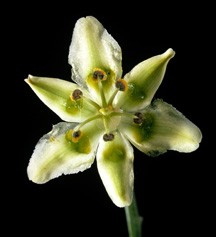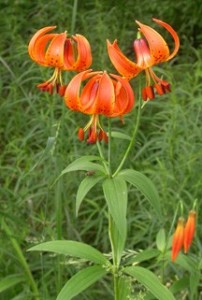Lilies
- Share
- Tweet
- Pin
- Share
How eagerly we wait for the lilies, both wild and tame, to begin producing their dazzling displays. It was when I worked at the Ridges Sanctuary that, in a sense, I dreaded mid-summer. It was a time when our visiting number of people was the greatest and also a time when few native wildflowers were in bloom.
A species of wild lily came into bloom that lifted our spirits considerably. It is the White Camass Lily, better known as the Death Camass Lily in various parts of the country where, if eaten by cattle, it can be quite deadly.

The Death Camass or Wand Lily has nectar that can stupefy small winged insects if they overindulge.
Even their typical six-parted blossoms play tricks on visiting insects. The flowers’ nectar has a stupefying effect on any tiny winged creature that overindulges in the liquid “treat.” Our good friend of past years, Dr. Albert Fuller, one of the sanctuary’s founders, called it “Wand Lily,” a fitting term which I especially like. The tall slender spikes of light greenish flowers do have a very graceful movement in even the slightest summer breeze.
A lily, in the narrowest sense, is restricted to the genus Lilium. The Lily family, however, is quite large and included some of the northern hemisphere’s most well-loved plants. Even some vegetables, such as onions and asparagus, are members of the great family.
The “spring woods awakening” contains such old favorites as Bellwort, Leek, Trout Lily and several species of trilliums. Later in summer come the Twisted Stalk, Canada Mayflower, Solomon’s Seal, Clintonia or Blue-bead Lily, and the brilliant Turk’s-cap and Wood Lilies.
The spectacular upright orange Wood Lily of mid-summer is rare in Wisconsin. Door County is one of the few counties where it can be found. The orange-red, dark spotted wildflower is named after the city of Philadelphia and is very indifferent to cultivation. By far the best specimens are found in a wild state. We consider it to be a protected wildflower in spite of changed laws in Wisconsin.
Most people, upon seeing a Wood Lily for the first time, ask if it is a Tiger Lily. The answer is no. That lily, Lilium tigrinum (ti-GRY-num) somewhat resembles the Wood Lily but has leaves which are not in a whorled arrangement around the stem as they are on the Wood Lily.
Several other large attractive lilies are native to other areas in the United States. Included are Canada, Leopard, Desert and Washington. The latter grows in the upper pine forests of the Sierra Nevada Mountains. and was named in honor of the first president of our country.
The Turk’s-cap Lily, cousin to the Wood Lily, is a later flower of the meadows. As a boy I often saw them growing along the railroad right-of-ways west of Kewaunee near what we called the Shooting Park. These orange blossoms with black spots, named after Michigan, are taller and hang downward.
The Day Lily, introduced from Eurasia, is now at its peak in this area. Its genus name is Hemerocalis and means day beauty or beautiful for a day. Few garden flowers are as hardy and require as little protection as this tawny orange lily. The species that grew next to our kitchen door at the Ridges was Hemerocalis fulva. Its three inner segments have wavy margins. Its clumps of fleshy tubers should be divided every few years for best results.

These Michigan Lilies are very closely related to the Turk’s-cap Lily.
Another lily, the Madonna Lily, given to us by Emma Toft some years ago, was the center of interest in our garden. It is the species candidum, meaning white, and is occasionally called the Common White lily. In my estimation there is nothing common about this immaculate fragrant flower.
It was brought to this country many years ago from Eurasia. Historians tell us that it was cultivated there in gardens for more than 5,000 years. Surely it is one of the world’s most well-known symbols of purity and perhaps has the longest and best known history of any flower. It was sacred in ancient times and associated with the Virgin Mary during the early Christian era.
Lilies are considered to possess, better than any other group of flowers, a combination of gracefulness, beauty and stately magnificence. Their petals and sepals are usually colored alike and each blossom has six stamens. Their fruit is a many-seeded capsule.
Nurserymen have developed many exotic sub-species. However about 100 species are well known and about 60 are real favorites in our country. Strangely Asiatic lilies, like the Madonna, seem to thrive better under cultivation here than the European and even our own native plants.
Quite a few lilies are typical hawkmoth flowers when it comes to being pollinated. The Turk’s-cap Lily, for example, hangs downward providing the insect visitors with no perches. Nectar is secreted by nectar grooves at the base of the petals. In order to reach this delicacy the moth makes use of its long tongue and ability to hover in mid-air like a hummingbird. Anthers on the flower, containing the pollen, swing loosely to and fro quite freely and are brushed against often by the moths. Their pollen-laden bodies are bound to touch the rather long eccentric stigmas of other Turk’s-cap Lilies during the moths’ nighttime visits.
From the lowly onion-garlic scented leeks of the April woodlands to the sprawling naturalized patches of Daylilies marking the sites of homesteads that have long disappeared from the landscape, lilies continue to be champions of innocence, purity and magnificence. In fact it would be difficult to imagine being any closer to paradise than when “in the beauty of the lilies.”
